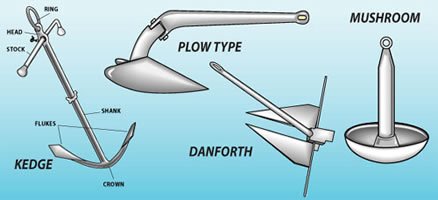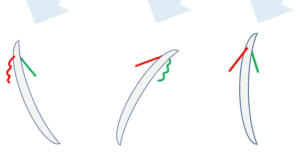Anchor Types

- Kedge Anchors – Used for centuries they are the traditional anchor shape we are used to. Modern kedge style anchors are lighter and have been adapted for specialized use. Sharp bills and small flukes hold better in hard sand. Broader flukes and larger arms hold better in soft bottoms or rocks and coral. Kedge anchors are often used successfully in heavy vegetation.
*Softer bottoms, hard sand, Rocks and Coral, Weeds
- Plow Anchors – When the plow anchor first lands, it is on its side but as it gets pulled the anchor rights itself and gradually plows into the bottom. It buries itself and holds well. Because this anchor type swivels horizontally on a hinged shaft, it resists pulling out when the direction of pull changes as when the boat shifts because of tide change. The CQR is a robust anchor often chosen by blue water cruisers as a storm anchor.
*Sand and stiff Mud, Grass pebble can hold in coral
- Danforth Anchors – The anchor lands on the bottom flat on its side. The rod like stock extend on both sides to keep the anchor from rotating and the flat crown pieces keep the flukes in position. The anchor gradually buries itself. Can come undone if there is a large shift in the direction of pull from the boat such as in tide change. If the bottom does not allow for digging in such as hard or rocky, or weedy, then the flukes can’t bury and the anchor will not set.
*Best in Clay, Sand and Mud
- Mushroom – This style of anchor is designed to gradually dig itself deeper and once imbedded has excellent holding ability.
*Silt, Mud
Spread the love




